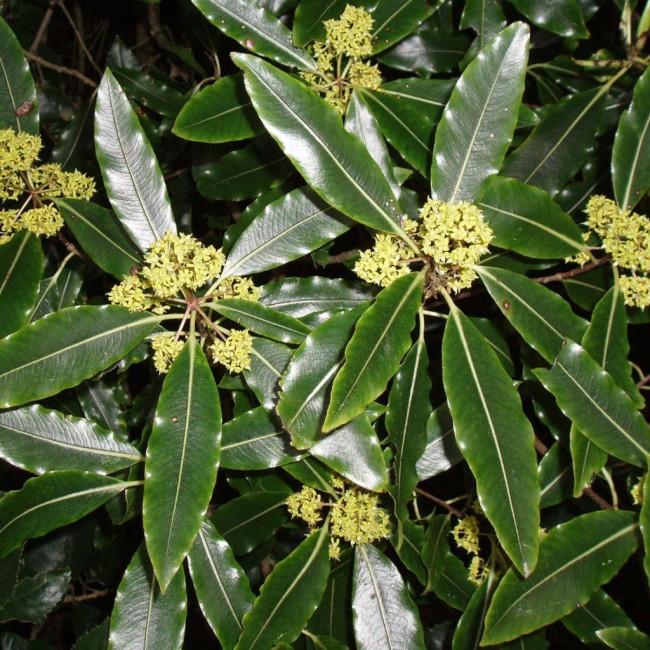
Pittosporum tobira. http://www.toptropicals.com.
I wish there were more days like today outside. If most March days are a spring tease, today was a Godsend of warmth! It was about 75 degrees earlier and I have the sunburns to show for my long day spent in the beautiful weather (actually it was work related, but still!) While warmth in March is quite brief (as a matter of fact- in only 24 hours it will be below freezing and snowing again) the warmth was enough for a few maples to start blooming- of which I will note their unique fragrance later. Days like today remind me that spring is very close- so I need to finish my subtropical winter weather bloomers quickly!
Pittosporum tobira is another one of those transplanted Asian winter bloomers that southerners will again enjoy out in the element; but of all the plants on the list- it is the easiest to grow in a pot. There are even variegated forms for the indoor gardener, and I’ve seen many of these outdoors in Florida as well. Practically a succulent, Pittosporum tobira grows on many beaches in the south, which was the first and only time I’ve seen this plant in bloom. A few years ago on a spring vacation trip to Hilton Head Island in South Carolina- I stumbled across a big group of Pittosporum tobira bushes on my way down to the beach, and couldn’t believe the scent coming from the flowers! While the plant is often called Japanese Mockorange, it should be called Mock Jasmine instead- as the flowers to my nose smell exactly like Jasmine tea. Others will say orange blossom or lillies; Tovah Martin in The Essence of Paradise said Easter lillies with baby powder and a touch of lemon. Either way, its definitely a good, sweet floral.
Pittosporum are yet another great landscape plant, and are a common sight along the Gulf Coast and in Florida. They are hardy to zone 9, perhaps 8b, and are another plant I would add if I had a southern garden of my own. They bloom outdoors from March through April, and in greenhouses from March until May. The flowers are a creamy white that age to a golden ochre before dropping, adding a visual pleasure to the olfactory one.

Pittosporum eugenioides. http://www.topseeds.co.nz.
Other Pittosporum species in America include many native to Hawaii. Many of the Pittosporum species are also fragrant/night fragrant, and others grown in the states include Pittosporum eugenioides, Pittosporum rhombifolia, and Pittosporum undulatum. Pittosporum undulatum is frequently grown in Mediterranean climates and is seen as a weed in many parts of the world, but it also has a knockout fragrance giving it the name Mock Orange. Pittosporum eugenioides is also heavily fragrant, almost like Cestrum nocturnum, but more chocolate-like. Its so strong, it makes all of Los Angeles partake of its essence during the late winter and early spring. I would have never known it was this plant that made LA smell so wonderful had I not happened to see it at Fairchild gardens back in January and was instantly transported back to LA by the fragrance. Smell is such a wonderful thing for memories, right?
Overall, this is another wonderfully fragrant family with great usage in the landscape and in the fragrance arena. Some of the seeds can make oil, and P. eugenioides has wonderfully lemon-scented leaves as well. So whether you live in California or Florida, go out and sniff out a Pittosporum for me!
